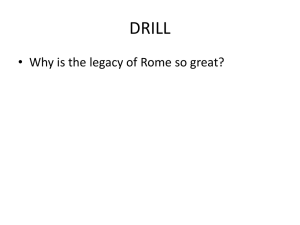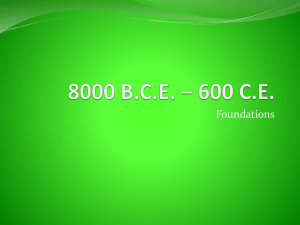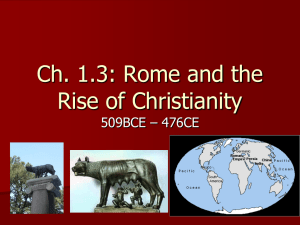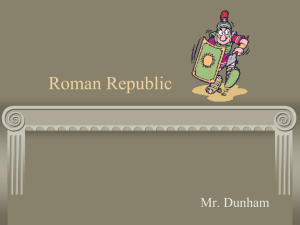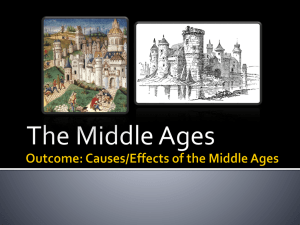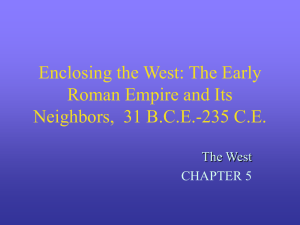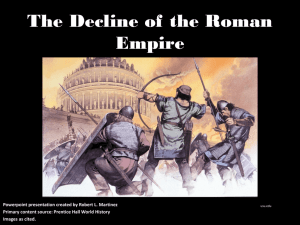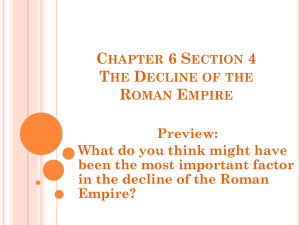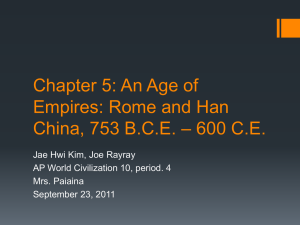Roman Empire - Moore Public Schools
advertisement
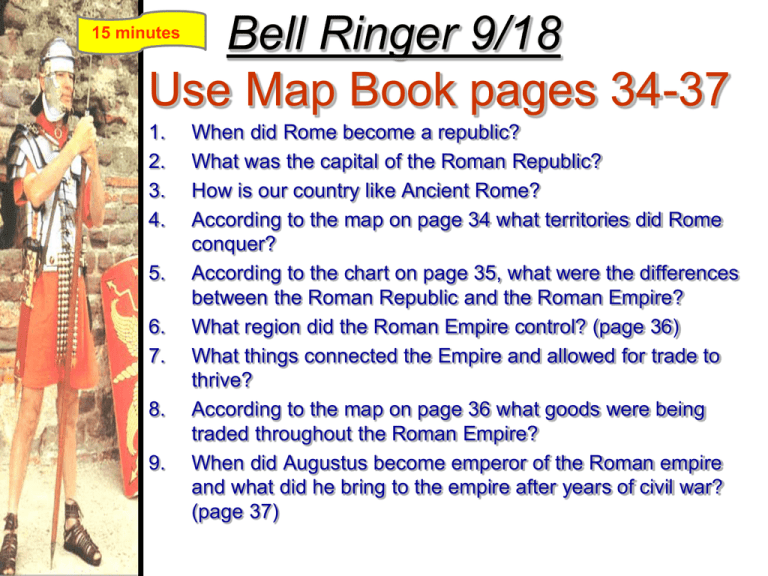
Bell Ringer 9/18 Use Map Book pages 34-37 15 minutes 1. 2. 3. 4. 5. 6. 7. 8. 9. When did Rome become a republic? What was the capital of the Roman Republic? How is our country like Ancient Rome? According to the map on page 34 what territories did Rome conquer? According to the chart on page 35, what were the differences between the Roman Republic and the Roman Empire? What region did the Roman Empire control? (page 36) What things connected the Empire and allowed for trade to thrive? According to the map on page 36 what goods were being traded throughout the Roman Empire? When did Augustus become emperor of the Roman empire and what did he bring to the empire after years of civil war? (page 37) Roman Republic – Roman Empire Essential Questions; 1. What was the connection between Socrates, Plato, and Aristotle? 2. What are some of the important contributions of Greek Philosophy to Western Civilization? 3. How did the government of the Roman Republic become more democratic in its decision making? 4. What was Pax Romana and what was its impact on the Roman Empire and modern international law? 5. How did Roman achievements influence Western Civilization? 6. What factors contributed to the eventual destruction of the Roman Empire? 7. How did Christianity become established within the Roman Empire? Essential Vocabulary: • • • • • • • • • Roman Empire Twelve tables Julius Caesar Triumvirate Augustus Caesar Pax Romana Christianity Constantine Byzantine Empire The Geography of Rome Italy in 750 BCE Influence of the Etruscans Writing Religion The Arch The Mythical Founding of Rome: Romulus & Remus Republican Government 2 Consuls (Rulers of Rome) Senate (Representative body for patricians) Tribal Assembly (Representative body for plebeians) The Twelve Tables, 450 BCE Providing political and social rights for the plebeians. Carthaginian Empire Hannibal’s Route Punic Wars Reform Leaders Tiberius and Gaius Gracchus • the poor should be given grain and small plots of free land. Military Reformer Gaius Marius • recruited an army from the poor and homeless. • professional standing army. Greek and Roman Domination Crossing the Rubicon, 49 BC The Die is Cast! http://www.mrdowling.com/702-caesar.html Civil War & Dictators Julius Caesar Pompey The First Triumvirate Julius Caesar Marcus Licinius Crassus Gaius Magnus Pompey Beware the Ides of March! 44 BCE The Second Triumvirate Octavian Augustus Marc Antony Marcus Lepidus Octavian Augustus: Rome’s First Emperor http://www.mrdowling.com/702-augustus.html The First Roman Dynasty Pax Romana: 27 BCE – 180 CE The Roman Colosseum The Colosseum Interior Circus Maximus Pax Romana: 27 BCE – 180 CE Pax Romana: 27 BCE – 180 CE The Roman Forum Roman Roads: The Appian Way Roman Aqueducts The Greatest Extent of the Roman Empire – 14 CE St. Paul: Apostle to the Gentiles Imperial Roman Road System The Rise of Christianity The Empire in Crisis: 3rd Century The Spread of Christianity • St. Peter’s Cathedral • Home of the Vatican • Home of the Catholic Church Diocletian Splits the Empire in Two: 294 AD Constantine: 312 - 337 • Constantine the Great was the first emperor of Rome to convert to Christianity • During his reign, Christians, previously persecuted, gained freedom of worship • He gave huge estates and other gifts to the Christian church • He established a capital in the eastern provinces, naming it Constantinople (now Istanbul, Turkey) Constantinople: “The 2nd Rome” (Founded in 330) Byzantium: The Eastern Roman Empire Barbarian Invasions: 4c-5c 476 AD The Legacy of Rome Republic Government Roman Law Latin Language Roman Catholic Church City Planning Romanesque Architectural Style Roman Engineering • Aqueducts • Sewage systems • Dams • Cement • Arch

